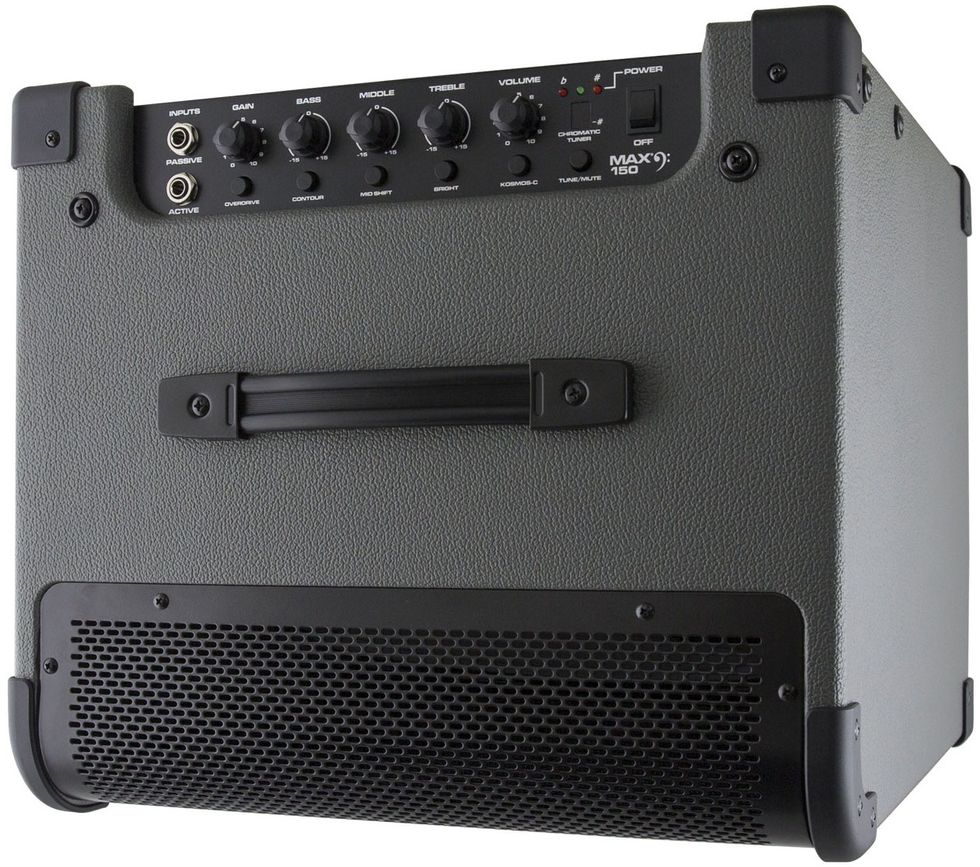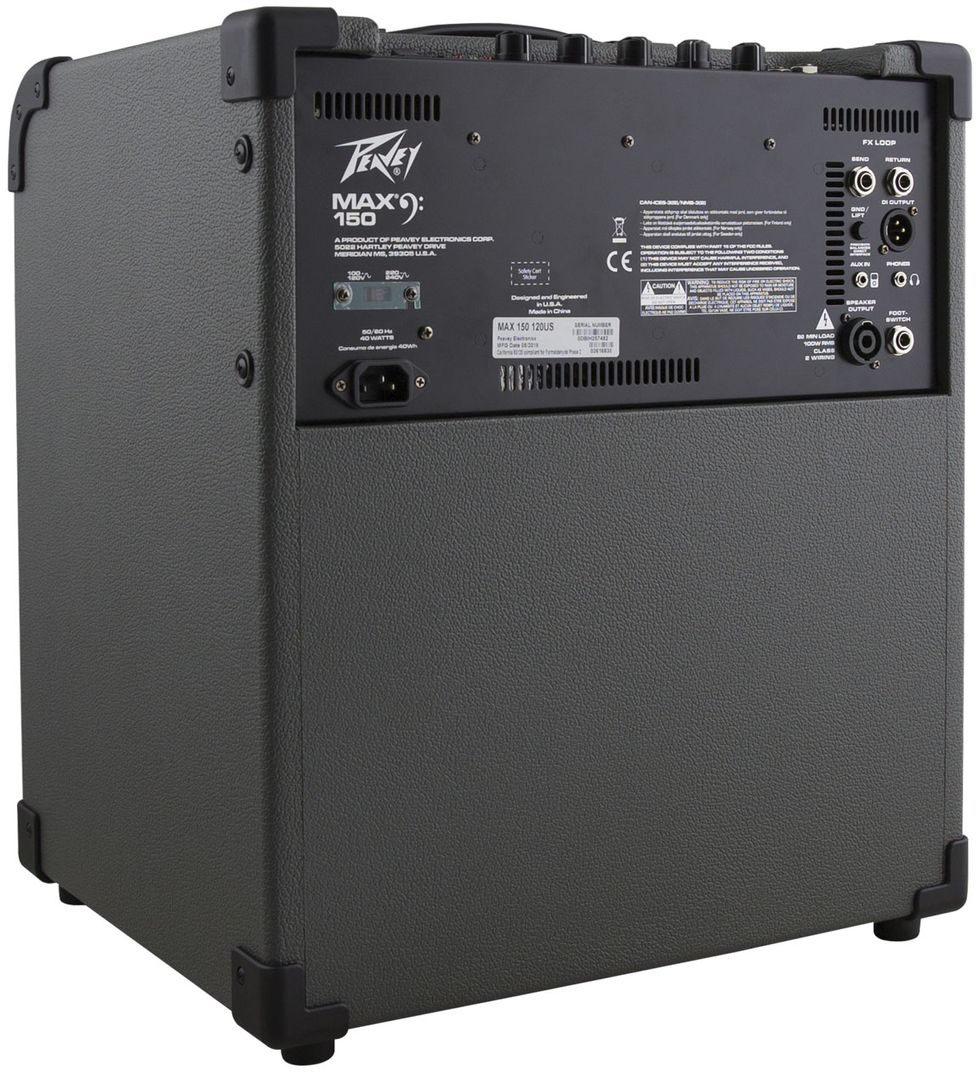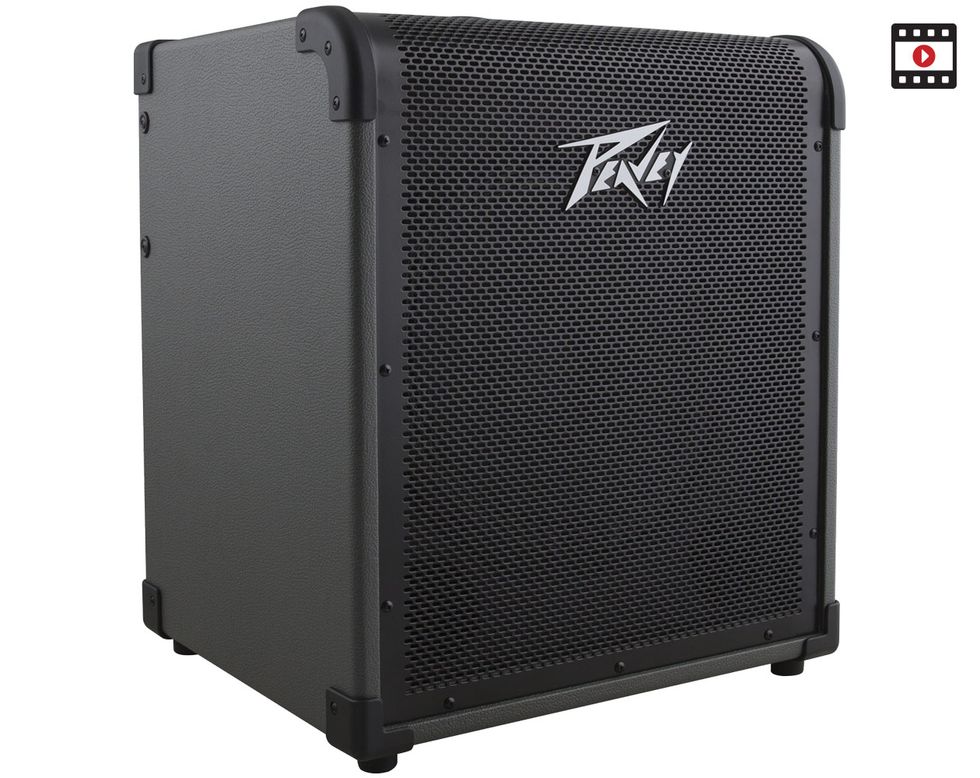Clip 1: [Using Fender Elite PJ] Slight cut on bass, slight boost of mid at 250 Hz, treble flat.
Clip 2: [Using Squier Contemporary HH Jazz] EQ flat.
RatingsPros:Thoughtful features packed into a rugged, portable package. Cons: Some loss of clarity with Kosmos-C low enhancement. Noticeable popping sound when tuning and manipulating switches. Street: $349 Peavey Max 150 peavey.com | Tones: Ease of Use: Build/Design: Value: |
For bassists on the go, combos are often the handiest means of amplification. And technological innovations over the years have expanded the functionality of these portable devices into all-in-one tools for both practice and performance. Peavey has a long and successful history in the combo game, and the company has consistently enhanced their offerings with the latest developments. Peavey’s Max series amps have undergone many transformations as they’ve evolved, and the latest iteration has all the signs of being a standout in its lineage. The refreshed series contains various pairings of speakers and power amps in the four models offered, but our focus here is the Max 150, Peavey’s 1x12 offering with 150 watts of thumpability.
Peavey Parts
Peavey employs an angled baffle with a “waterfall” grille over the front of the cabinet, which is likely the most noticeable visual difference in the modern Max combos. The shaping was designed for better high-frequency dispersion when the combo is on the floor, and helps eliminate the need to tilt the speaker cabinet.

Peavey’s tone-shaping options for the Max 150 combine signature features with a streamlined EQ. Inputs for both active and passive basses will accommodate a variety of pickups. The gain section has overdrive capability via the switch below the gain dial, and, next door, a few spices are added to the 3-band EQ.
Below the bass control is a contour switch, which scoops the EQ by cutting mids and boosting highs and lows. The mid-shift switch adjusts the center frequency for the mids to either 600 Hz or 250 Hz. If your tone requires a little shine, the bright switch delivers a 10 dB boost to frequencies above 1 kHz. Conversely, the Kosmos-C switch (aka booty button) creates a massive amount of low end for the subsonic fan. According to Peavey, this enhancement creates harmonics of signals in the bottom octave, providing a perception of stronger bass.
Practical additions to Peavey’s latest expand its versatility. They consist of a chromatic tuner, effects loop, DI, speaker output, footswitch jack, and a pair of mini inputs for headphones and playback devices. There’s a lot packed into this under-30-pound package.
Take It to the Max
The Max 150 made a great first impression. The strong handle and rugged design instilled confidence it could manage the rigors of working musicians. Historically, I’ve found the looks of Peavey’s products to be hit-or-miss, but the Max 150 gets top marks for its sleek styling and a super-cool grille. In addition to being lightweight, its compact shape made it easy to transport.
I employed a Fender Elite PJ and a Squire Contemporary Active Jazz HH to explore the amp’s tones. The combo produced strong midrange definition, thick lows, and smooth highs. Never did the Max 150 feel lacking in the EQ department, since I could temper or beef up the sound as needed. The PJ’s voice opened up with a slight boost at 250 Hz and a slight cut in the bass control. On the other hand, Squire’s modern zinger really sang with the bright switch engaged, and I found the contour switch to be sonically effective when slapping and popping strings.
Those who dig a little dirt in their tone will likely appreciate the Max 150’s distortion capabilities. I was easily able to go from a slight bite to full-on gnash without worrying about damaging the essential components. Thanks to Peavey’s proprietary DDT limiter, safe operation is assured when pushing the gain to its—ahem—max. Even if you’re not a regular user of distortion, having it available in the combo is a convenient alternative to schlepping a pedal and additional cables for when you do need it.

Strobe tuners are typically my preferred pitch-fixer, but I was happy to find that the onboard chromatic tuner is fast and accurate. After tuning up both basses using the combo’s tuner, I plugged them into a Peterson StroboStomp Classic for comparison and found the open strings to be dead-on in tune.
I had a couple of quibbles with Peavey’s little monster. While the engaged Kosmos-C does what it’s supposed to by producing lots of low end, I felt that bass notes had a tendency to lose clarity and articulation. This function could be great for dub-heavy players, but I found it to be a bit too muddy for some styles. The other concern came when engaging the switches and tuner. The combo emitted a slight yet noticeable pop when pressing and un-pressing the buttons, and using the tuner. This wouldn’t be much of an issue when practicing at home, but could be a potential irritation when miking the cab at shows.
Speaking of shows, I did take the Max 150 to a blues jam, where the amp was part of the house band’s gear. No, the 150-watt amp couldn’t contend with loud guitars and drums on its own, but it did function well as a personal monitor while, thanks to the amp’s DI, the mains and monitors of the house system reinforced my tone. I don’t know if the angled baffle provided a significant increase in sound, but I was able to hear fairly well with the amp on the stage floor.
The Verdict
Peavey’s Max 150 puts a fresh face on the Max combo lineage by augmenting Peavey’s consistently rugged design with contemporary features. It’s a solid amp for home practice, a coffee-shop show, or small-room rehearsals. You’d typically be hard-pressed to find a quality amp for less than $350, but you can still count on Peavey to offer a solid product with great value.
Watch the Review Demo:








![Rig Rundown: AFI [2025]](https://www.premierguitar.com/media-library/youtube.jpg?id=62064741&width=1245&height=700&quality=70&coordinates=0%2C0%2C0%2C0)












 Shop Scott's Rig
Shop Scott's Rig


![Rig Rundown: Russian Circles’ Mike Sullivan [2025]](https://www.premierguitar.com/media-library/youtube.jpg?id=62303631&width=1245&height=700&quality=70&coordinates=0%2C0%2C0%2C0)












































